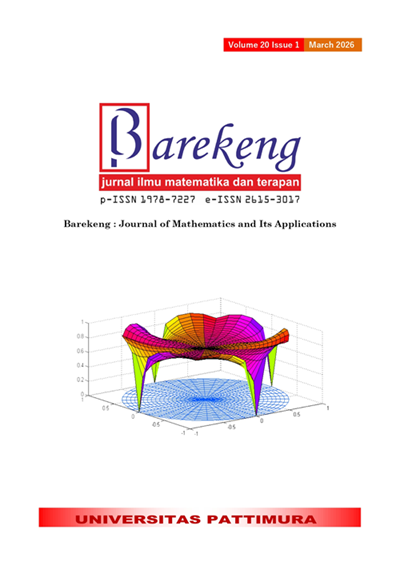HYBRID METHOD IMPLEMENTATION: FUZZY DECISION TREE IN THE CLASSIFICATION OF GENDER INEQUALITY
Abstract
The classification of continuous data using the C4.5 decision tree algorithm requires prior discretization based on the calculation of cut points, a process that can be time-consuming and potentially introduce bias. These limitations may negatively impact both the computational efficiency and the classification accuracy of the decision tree model. This study proposes a hybrid method that integrates fuzzy logic with decision tree techniques in the classification process of continuous data types. Fuzzy logic is utilized to manage uncertainty in data variables and enhance flexibility in processing continuous values, while the decision tree plays a role in providing a structured and rule-based framework for decision-making. This proposed method is applied to gender inequality data, encompassing aspects of reproductive health, education and empowerment, and employment across 166 countries worldwide. The results demonstrate that the fuzzy decision tree method, which was constructed using the C4.5 algorithm, achieved a classification accuracy of 91%, while the C4.5 decision tree method without fuzzy only achieved a classification accuracy of 77%. The fuzzy decision tree method successfully improved the classification accuracy by 14%. Additionally, the fuzzy decision tree exhibited more stable and balanced performance in classifying data into four target categories. Therefore, this approach offers an effective and comprehensive alternative for classifying gender inequality, with the potential to support data-driven and targeted policy-making.
Downloads
References
H. Bin Wang and Y. J. Gao, “RESEARCH ON C4.5 ALGORITHM IMPROVEMENT STRATEGY BASED ON MAPREDUCE,” Procedia Comput Sci, vol. 183, pp. 160–165, 2021. doi: https://doi.org/10.1016/j.procs.2021.02.045
C. T. Lee and S. C. Horng, “ABNORMALITY DETECTION OF CAST-RESIN TRANSFORMERS USING THE FUZZY LOGIC CLUSTERING DECISION TREE,” Energies (Basel), vol. 13, no. 10, May 2020. doi: https://doi.org/10.3390/en13102546
S. B. Begenova and T. V. Avdeenko, “BUILDING OF FUZZY DECISION TREES USING ID3 ALGORITHM,” in Journal of Physics: Conference Series, Institute of Physics Publishing, May 2018. doi: https://doi.org/10.1088/1742-6596/1015/2/022002
A. Jain and A. Sharma, “MEMBERSHIP FUNCTION FORMULATION METHODS FOR FUZZY LOGIC SYSTEMS: A COMPREHENSIVE REVIEW,” Journal of Critical Reviews, vol. 7, pp. 8717–8733, 2020. doi: https://doi.org/10.31838/jcr.07.19.980
N. F. Idris, M. A. Ismail, M. S. Mohamad, S. Kasim, Z. Zakaria, and T. Sutikno, “BREAST CANCER DISEASE CLASSIFICATION USING FUZZY-ID3 ALGORITHM BASED ON ASSOCIATION FUNCTION,” IAES International Journal of Artificial Intelligence, vol. 11, no. 2, pp. 448–461, Jun. 2022. doi: https://doi.org/10.11591/ijai.v11.i2.pp448-461
E. S. Kresnawati, B. Suprihatin, and Y. Resti, “THE COMBINATIONS OF FUZZY MEMBERSHIP FUNCTIONS ON DISCRETIZATION IN THE DECISION TREE-ID3 TO PREDICT DEGENERATIVE DISEASE STATUS,” Symmetry (Basel), vol. 16, no. 12, Dec. 2024. doi: https://doi.org/10.3390/sym16121560
H. B. Santoso, “FUZZY DECISION TREE TO PREDICT STUDENT SUCCESS IN THEIR STUDIES,” International Journal of Quantitative Research and Modeling, vol. 1, no. 3, pp. 135–144, 2020, doi: https://doi.org/10.46336/ijqrm.v1i3.59
S. M. S. Askari and M. A. Hussain, “IFDTC4.5: INTUITIONISTIC FUZZY LOGIC BASED DECISION TREE FOR E-TRANSACTIONAL FRAUD DETECTION,” Journal of Information Security and Applications, vol. 52, Jun. 2020. doi: https://doi.org/10.1016/j.jisa.2020.102469
“HUMAN DEVELOPMENT REPORTS 2021/2022,” Geneva, 2023. Accessed: Apr. 14, 2025. [Online]. Available: https://hdr.undp.org/content/human-development-report-2021-22
E. Di Bella, S. Fachelli, P. López-Roldán, and C. Suter, MEASURING GENDER EQUALITY A MULTIDISCIPLINARY ANALYSIS OF SOME EU COUNTRIES, vol. 87. Cham: Springer Nature, 2023. doi: https://doi.org/10.1007/978-3-031-41486-2
J. S. Muthmaina, “THE FEMININOMENON OF INEQUALITY: A DATA-DRIVEN ANALYSIS AND CLUSTER PROFILING IN INDONESIA,” Computers and Society, Nov. 2024. doi: https://doi.org/10.48550/arXiv.2412.00012.
J. Han, M. Kamber, and J. Pei, DATA MINING. CONCEPTS AND TECHNIQUES, 3RD EDITION (THE MORGAN KAUFMANN SERIES IN DATA MANAGEMENT SYSTEMS), 3rd ed. Waltham: Elsevier Inc., 2012. doi: https://doi.org/10.1016/C2009-0-61819-5
H.-J. Zimmermann, FUZZY SET THEORY—AND ITS APPLICATIONS, 4th ed. New York: Springer Science+Business Media, 2001. doi: https://doi.org/10.1007/978-94-010-0646-0
F. Li, C. Shang, Y. Li, J. Yang, and Q. Shen, “APPROXIMATE REASONING WITH FUZZY RULE INTERPOLATION: BACKGROUND AND RECENT ADVANCES,” Artif Intell Rev, vol. 54, no. 6, pp. 4543–4590, Aug. 2021. doi: https://doi.org/10.1007/s10462-021-10005-3
S. H. Khairuddin, M. H. Hasan, M. A. Hashmani, and M. H. Azam, “GENERATING CLUSTERING-BASED INTERVAL FUZZY TYPE-2 TRIANGULAR AND TRAPEZOIDAL MEMBERSHIP FUNCTIONS: A STRUCTURED LITERATURE REVIEW,” Symmetry (Basel), vol. 13, no. 2, Feb. 2021. doi: https://doi.org/10.3390/sym13020239
Y. Resti, C. Irsan, M. Amini, I. Yani, R. Passarella, and D. A. Zayanti, “PERFORMANCE IMPROVEMENT OF DECISION TREE MODEL USING FUZZY MEMBERSHIP FUNCTION FOR CLASSIFICATION OF CORN PLANT DISEASES AND PESTS,” Science and Technology Indonesia, vol. 7, no. 3, pp. 284–290, 2022. doi: https://doi.org/10.26554/sti.2022.7.3.284-290
T. Sutikno, A. C. Subrata, and A. Elkhateb, “EVALUATION OF FUZZY MEMBERSHIP FUNCTION EFFECTS FOR MAXIMUM POWER POINT TRACKING TECHNIQUE OF PHOTOVOLTAIC SYSTEM,” IEEE Access, vol. 9, pp. 109157–109165, 2021. doi: https://doi.org/10.1109/ACCESS.2021.3102050
L. A. Zadeh, “FUZZY SETS,” INFORMATION AND CONTROL, vol. 8, pp. 338–353, 1965. doi: https://doi.org/10.1016/S0019-9958(65)90241-X
S. Lotfi, M. Ghasemzadeh, M. Mohsenzadeh, and M. Mirzarezaee, “SCALABLE DECISION TREE BASED ON FUZZY PARTITIONING AND AN INCREMENTAL APPROACH,” International Journal of Electrical and Computer Engineering, vol. 12, no. 4, pp. 4228–4234, Aug. 2022. doi: https://doi.org/10.11591/ijece.v12i4.pp4228-4234
F. Es-sabery and A. Hair, “A MAPREDUCE C4.5 DECISION TREE ALGORITHM BASED ON FUZZY RULE-BASED SYSTEM,” FUZZY INFORMATION AND ENGINEERING, vol. 11, no. 4, pp. 446–473, 2019. doi: https://doi.org/10.1080/16168658.2020.1756099
I. Markoulidakis, I. Rallis, I. Georgoulas, G. Kopsiaftis, A. Doulamis, and N. Doulamis, “MULTICLASS CONFUSION MATRIX REDUCTION METHOD AND ITS APPLICATION ON NET PROMOTER SCORE CLASSIFICATION PROBLEM,” Technologies (Basel), vol. 9, no. 4, Dec. 2021. doi: https://doi.org/10.3390/technologies9040081
M. McCool-Myers, M. Theurich, A. Zuelke, H. Knuettel, and C. Apfelbacher, “PREDICTORS OF FEMALE SEXUAL DYSFUNCTION: A SYSTEMATIC REVIEW AND QUALITATIVE ANALYSIS THROUGH GENDER INEQUALITY PARADIGMS,” BMC Womens Health, vol. 18, no. 1, Jun. 2018. doi: https://doi.org/10.1186/s12905-018-0602-4
Copyright (c) 2025 Siti Fatimah Marliany Irawan, Dewi Anggraini, Selvi Annisa

This work is licensed under a Creative Commons Attribution-ShareAlike 4.0 International License.
Authors who publish with this Journal agree to the following terms:
- Author retain copyright and grant the journal right of first publication with the work simultaneously licensed under a creative commons attribution license that allow others to share the work within an acknowledgement of the work’s authorship and initial publication of this journal.
- Authors are able to enter into separate, additional contractual arrangement for the non-exclusive distribution of the journal’s published version of the work (e.g. acknowledgement of its initial publication in this journal).
- Authors are permitted and encouraged to post their work online (e.g. in institutional repositories or on their websites) prior to and during the submission process, as it can lead to productive exchanges, as well as earlier and greater citation of published works.






1.gif)



